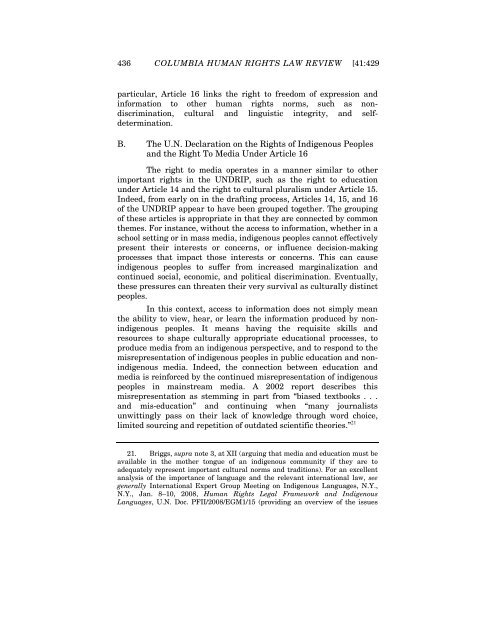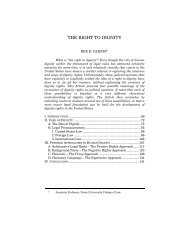A Right to Media? Lorie M. Graham - Columbia Law School
A Right to Media? Lorie M. Graham - Columbia Law School
A Right to Media? Lorie M. Graham - Columbia Law School
You also want an ePaper? Increase the reach of your titles
YUMPU automatically turns print PDFs into web optimized ePapers that Google loves.
436 COLUMBIA HUMAN RIGHTS LAW REVIEW [41:429<br />
particular, Article 16 links the right <strong>to</strong> freedom of expression and<br />
information <strong>to</strong> other human rights norms, such as nondiscrimination,<br />
cultural and linguistic integrity, and selfdetermination.<br />
B. The U.N. Declaration on the <strong>Right</strong>s of Indigenous Peoples<br />
and the <strong>Right</strong> To <strong>Media</strong> Under Article 16<br />
The right <strong>to</strong> media operates in a manner similar <strong>to</strong> other<br />
important rights in the UNDRIP, such as the right <strong>to</strong> education<br />
under Article 14 and the right <strong>to</strong> cultural pluralism under Article 15.<br />
Indeed, from early on in the drafting process, Articles 14, 15, and 16<br />
of the UNDRIP appear <strong>to</strong> have been grouped <strong>to</strong>gether. The grouping<br />
of these articles is appropriate in that they are connected by common<br />
themes. For instance, without the access <strong>to</strong> information, whether in a<br />
school setting or in mass media, indigenous peoples cannot effectively<br />
present their interests or concerns, or influence decision-making<br />
processes that impact those interests or concerns. This can cause<br />
indigenous peoples <strong>to</strong> suffer from increased marginalization and<br />
continued social, economic, and political discrimination. Eventually,<br />
these pressures can threaten their very survival as culturally distinct<br />
peoples.<br />
In this context, access <strong>to</strong> information does not simply mean<br />
the ability <strong>to</strong> view, hear, or learn the information produced by nonindigenous<br />
peoples. It means having the requisite skills and<br />
resources <strong>to</strong> shape culturally appropriate educational processes, <strong>to</strong><br />
produce media from an indigenous perspective, and <strong>to</strong> respond <strong>to</strong> the<br />
misrepresentation of indigenous peoples in public education and nonindigenous<br />
media. Indeed, the connection between education and<br />
media is reinforced by the continued misrepresentation of indigenous<br />
peoples in mainstream media. A 2002 report describes this<br />
misrepresentation as stemming in part from “biased textbooks . . .<br />
and mis-education” and continuing when “many journalists<br />
unwittingly pass on their lack of knowledge through word choice,<br />
limited sourcing and repetition of outdated scientific theories.” 21<br />
21. Briggs, supra note 3, at XII (arguing that media and education must be<br />
available in the mother <strong>to</strong>ngue of an indigenous community if they are <strong>to</strong><br />
adequately represent important cultural norms and traditions). For an excellent<br />
analysis of the importance of language and the relevant international law, see<br />
generally International Expert Group Meeting on Indigenous Languages, N.Y.,<br />
N.Y., Jan. 8–10, 2008, Human <strong>Right</strong>s Legal Framework and Indigenous<br />
Languages, U.N. Doc. PFII/2008/EGM1/15 (providing an overview of the issues















